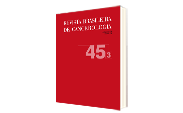Knowledge of People about Câncer Prevention in Brazil
DOI:
https://doi.org/10.32635/2176-9745.RBC.1999v45n3.2781Palabras clave:
Cancer Knowledge, Risk Factors, Cancer PreventionResumen
Several associations between cancer and some risk factors mainly concerning lifestyle, are well established. In view of the importance to convey this knowledge to the population for effective cancer prevention, this research was carried out to assess the level of information in a population in the countryside of Brazil. A survey by household interview was carried out in a probabilistic sample of four towns in order to obtain data on the knowledge of people about the association between tobacco, alcohol, certain types of food and sunlight, and the occurrence of cancer. The sample was obtained in a two phases process (blocks and houses) and every person older than 20 years was interviewed in the selected house. A total of 1084 persons were interviewed and their level of knowledge about the association between cancer and the risk factors was low (60% for tobacco, 45% for alcohol, 39% for certain foods and 67% for solar irradiation). This level increased with schooling and socioeconomic levei and decreased with age for people older than 60 years. This did not occur for alcohol, for which the trend went in the opposite direction regarding schooling and social class. The level of knowledge about these associations was higher for women. These data permitted us to identify population groups which could benefit from programs aimed to change their style of life.
Descargas
Citas
WHO Technical Report Series no. 636, 1979. Controlling the Smoking Epidemic: Report of the WHO Expert Committee on Smoking Control.
Peto, R.; Lopes A.D. the WHO Consultative Group on Statistical Aspects of Tobacco Related Mortality. Worlwide Mortality from Current Smoking Patterns. In: Durston, B.; Jamrozik K., eds. Tobacco and Health, 1990: The Global War. Proceedings of the Seventh World Conference on To bacco and Health. Perth, Health Depart ment of Wertern Australia, 1990.
Harber, L. C.: Causes and Effects of Changes in Stratospheric Ozone: Update 1983. National Research Council, National Academy of Sciences, 135-249. National Academy Press, Washington D. C., 1984.
Gallagher, R. P; Hill, G. B.; Badjik, C. D. et all. Sunlight Exposure, Pigmentation Factors and Risk of Nonmelanocytic Skin Câncer. II. Squamous cell carcinoma. Arch. Dermatol. 131:164-9, 1995. DOI: https://doi.org/10.1001/archderm.131.2.164
Armstrong, B. K.; Kricher, A. How Much Melanoma Is Caused by Sun Exposure? MelanomaRes. 3:395-401, 1993. DOI: https://doi.org/10.1097/00008390-199311000-00002
Committee on Diet, Nutrition and Câncer, Assembly of Life Sciences. National Research Council: Diet, Nutrition and Cancer.National Academy Press, Washing ton D. C., 1982.
Miller, A. B.: Nutrition and Câncer. Prev. Med. 9:189-196, 1980. DOI: https://doi.org/10.1016/0091-7435(80)90074-2
Gupta, P. C.; Hebert, J. R.; Bhonsle, R. B. et all. Influence of Dietary Factors on Oral Precancerous Llesions in a Population-Based Case-Control study in Kerala, índia. Câncer 85(9): 1885-93, 1999. DOI: https://doi.org/10.1002/(SICI)1097-0142(19990501)85:9%3C1885::AID-CNCR2%3E3.0.CO;2-O
Ward, M. H.; Lopez-Carrillo, L. Dietary Factors and the Risk of Gastric Câncer in México City. Am. J. Epidemiol. 149(10):925-32, 1999. DOI: https://doi.org/10.1093/oxfordjournals.aje.a009736
Brasil, Ministério da Saúde-Secretaria Nacional de Assistência à Saúde. Instituto Nacional do Câncer. Estimativa da Incidência e Mortalidade por Câncer no Brasil, 1999. INCA, 1999.
Lopes, E. R.; Rabelo, M. S.; Abreu, E. et al. Comportamento da População Brasileira Feminina em Relação ao Câncer Cérvico-Uterino. J. Bras. Ginecol. 105:505-516, 1995.
Gallup Organization: A Study Concerning Cigarette Smoking, Health Check-Ups and Câncer Detection Tests. The Gallup Organization Inc. Princeton, N. J., 1977
Lieberman, S. A Study of the Effecti veness of Altemative Brest Câncer Public Education Programmes. Lieberman Research Inc., New York, 1977.
Kegeles, S. S.; Grady, K. E.: Behavioral Dimensions. In: Schottenfeld, D., Fraumeni, J. R: Câncer Epidemiology and Prevention. Philadelphia, Saunders 1982.
Instituto Brasileiro de Geografia e Estatística (IBGE). Anuário Estatístico do Brasil - suplemento 1989.
Sociedade Brasileira de Pesquisa de Mercado (SBPM) - Personal Communication.
Winder, E. L.; Muskinski, M. H.; Spivac, J. C.: Tobacco and Alcohol Consumption in Relation to the Development of Multiple Primary Câncer. Câncer 40:1872 - 1878, 1977. DOI: https://doi.org/10.1002/1097-0142(197710)40:4+<1872::AID-CNCR2820400817>3.0.CO;2-#
Rao, D. N., Desai, P. B. Risk Assesment of Tobacco, Alcohol and Diet in Cancers of Base of Tongue and Oral Tongue - a Case-Control Study. Indian J. Câncer 35(2):65-72, 1998.
Win, D. M.; Blot, W. J.: Snuff Dipping and Oral Câncer Among Women in the Southern United States.New Engl. J. Med. 301: 745-749, 1981. DOI: https://doi.org/10.1056/NEJM198103263041301
De Stefani E.; Boffeta, R; Oreggia, E. et al. Smoking Patterns and Câncer of the Oral Cavity and Pharynx: a Case-Control Study in Uruguay. Oral Oncol. 34(5):340-6, 1998. DOI: https://doi.org/10.1016/S1368-8375(98)00014-1
Winder, E. L.: The Epidemiology of Câncer of the Upper Alimentary and Upper Respiratory Tracts. Laringoscope (Supp 8) 88:50-51, 1978.
Segai, I.; Reinach, S. G.; de Beer, M.: Factors Associated With Oesophageal Câncer in Soweto, South África. Br. J. Câncer 58:681-686, 1988. DOI: https://doi.org/10.1038/bjc.1988.286
Howe, G. R.; Burch, J. D.: Tobacco Use, Occupation, Coffee, Various Nutrients, and Bladder Câncer. J. Natl. Câncer Inst. 64:701-713, 1980.










